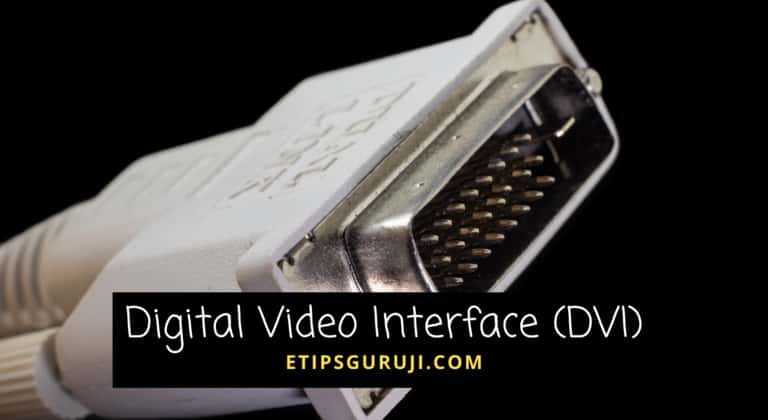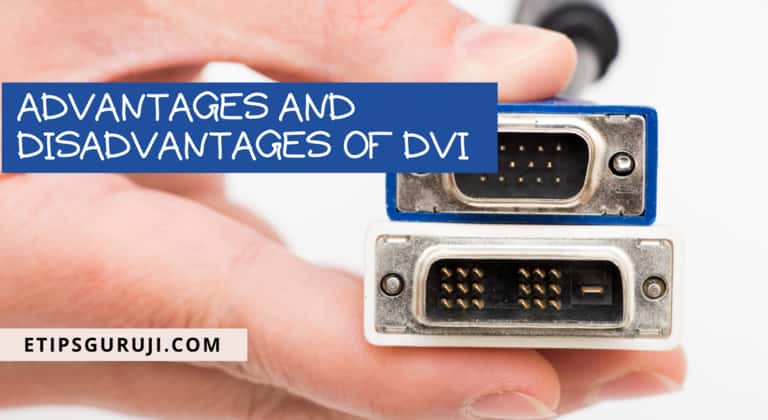Digital Video Interface (DVI): Types, Merits & Demerits

In this short post, we are going to discuss all Digital Video Interface (DVI). Along with it, we are also going to have a look at its types, advantages, disadvantages along with some general FAQ.
What is Digital Video Interface (DVI)?
Digital video interface (DVI) is one of the popular port for display interface that is used to connect the video streaming device to the screen display.
At a glance, it is developed by the Digital Display Working Group (DDWG) in 1999, as a replacement to the analog technology i.e. VGA (Video Graphics Array) connector standard. Through its digital content, it is that much compatible as compared with the VGA interface.
In short, DVI is the interface that is used to send video or to connect a video signal source (computer) to a display (LCD monitors, HDTV displays, projectors, and cable boxes).
People Also Read:
Types of Digital Video Interface Connectors (DVI Connector Types)

DVI connectors come in three different types:
- DVI-Analog (DVI-A)
- DVI-Digital (DVI-D)
- DVI-Integrated (DVI-I); analog and digital
DVI-Analog (DVI-A)
This type of Digital Video Interface connector is used to carry only analog signals to analog devices. It means it only carries a signal to an analog display (CRT monitor).
The computer, video adapter, graphics adapter, video card or graphics card converts digital data into an analog format that is sent to the monitor using this port.
This DVI Analog has three rows of pins. In the first row, it has five pins. The second row has three pins. And in the last or third row, it has four pins, and that “flat blade” contact seen to the left side, it has two contacts each above and below. However, in DVI analog cables, there is no single or dual-link.
- Total pins: 17 pins (12+5)
- Resolution Support: 1920×1200
- Refresh Rate: 60 Hz
- Aspect Ratio: 16:10
- Data transfer rate: 3.96 Gbps.
DVI-Digital (DVI-D)
This type of connector is a digital-only connection format only used by a digital signal, not by an analog signal. DVI-D will connect to DVI-I, DVI-D, or DFP. It has two types of ports:
DVI-D (Single-Link)
This kind of connector has come with a total of 19 pins. It has three rows of six pins. However, a DVI-D (Single-Link) connector has no contacts it has only a flat blade.
- Total pins: 19 pins
- Resolution Support: 1920×1200
- Refresh Rate: 60 Hz
- Aspect Ratio: 16:10
- Data transfer rate: 3.96 Gbps.
DVI-D (Dual-Link)
This special DVI-D (Dual-Link) connector is slightly thicker as compared to a single link. Although, it has three rows of eight pins, with no contacts only a flat blade.
- Total pins: 25 pins (alternately name a 24+1-pin or 24-pin connector)
- Resolution Support: 2560×1600
- Refresh Rate: 60 Hz
- Aspect Ratio: 16: 10
- Data transfer rate: 7.92 Gbps.
Difference Between DVI D Single and Dual Link
DVI-D and DVI-I also exist in Single Link and Dual Link varieties, making things even more complex. Because dual link supports greater resolutions, this is the main difference.
Dual-link cables have all 24 connectors, but single-link cables only have 18 pins.
DVI-Integrated (DVI-I); Analog and Digital
This integrated connector provides both types of signals i.e. analog and digital. DVI-I will connect to DVI-I, DVI-A, DVI-D, or DFP. DVI-I connectors come in two ports i.e. single-link and dual-link formats.
DVI-I (Single-Link)
This sort of connector specially designed and it has three rows, each with six pins having two missing pins in the center. As an integrated connector, it supports both analog and digital applications. That’s why it has two contacts above and below it with a flat blade/ single horizontal pin.
- Total pins: 23 pins
- Resolution Support: 1920×1200
- Refresh Rate: 60 Hz
- Aspect Ratio: 16:10
- Data transfer rate: 3.96 Gbps.
DVI-I (Dual-Link)
This best-of-the-best kind of connector can be used with both digital and analog applications. It increases the size of the resolution with a high speed of data transfer rate.
However, it is slightly thicker because it features more pins. Dual-link has three rows of eight pins as well as a single horizontal pin with two contacts above and below it.
- Total pins: 29 pins
- Resolution Support: 2560×1600
- Refresh Rate: 60 Hz
- Aspect Ratio: 16:10
- Data transfer rate: 7.92 Gbps.
Digital Video Interface DVI Port Types
DVI-I and DVI-D are the two most common types of DVI connections in use today. DVI-I may accommodate both digital and analog transmissions, but DVI-D solely offers a digital signal.
Digital Video Ports like Dell flat-panel monitors with DVI-D connections were released in January 2002 and may be used with both DVI-D and DVI-I video ports.
Advantages of Digital Video Interface (DVI)

These are some of the advantages of using a Digital Video Interface port and cable as a display port.
- DVI port carries signal much better than VGA with a faster transmission speed
- Better picture quality and look more realistic
- DVI has better backward compatibility
- DVI cable can simply plug and play
- DVI has separate cables and ports for analog i.e. DVI-A, for digital i.e. DVI-D, and integrated i.e. DVI-I
- DVI-D and DVI-I both have two types of cable/ port i.e. single link and dual-link.
- DVI-I cable and port have the adaptability to carry or support both signals i.e. analog signal (DVI-A) and digital signal(DVI-D).
People Also Read:
- What is Digitizer? Working With Common Examples
- How To Fix Mouse Double Clicks Problems? 5 Common Reasons & Fixes
- 7 Uses of Reversible Type-C Connector [Detailed Explanation]
- 9 Reasons Why is Aerial Cable TV Not Working With Simple Fixes
Disadvantages of Digital Video Interface (DVI)
The following are the disadvantages of using Digital Video Interface (DVI) as a display port:
- Confusion regarding due to many different versions.
- Sometimes transmitted signals get weak after reinstalling the system.
- Digital analog cable could not connect to the analog port.
- Due to its physical pin availability, a dual-link cable could not connect to the digital’s single-link port.
- DVI-I dual-port does not insert in the single link port.
With this, our article on “Digital Video Interface” ends. But there are a few frequently asked questions that can help you to get an overview of it.
General FAQs
What is Digital Visual Interface?
The Digital Display Working Group created the Digital Visual Interface (DVI), a video display interface (DDWG). When a display controller is connected to a computer monitor, the digital interface connects the two devices.
Different types of DVI Adaptors
Digital-only cables should be used for digital signals. If you have two DVI Adaptor types are DVI-D devices, you’ll need a DVI-D cable to connect them. A DVI-D to HDMI cable is needed if one end is DVI and the other HDMI.
What is the common difference and similarity between DVI-I and DVI-A?
DVI-I connector will have a full 24 pin set whereas the DVI-A connector has 17 pin set. However, the similarity between DVI-A and DVI-I cables is that both connect to receptors with two contacts above and below it.
What does a single link or dual link mean in Digital Video Interface?
Digital Video Interface connectors have two distinct links i.e. single link and dual-link formats. Single link DVI display up to 1920×1080 with a data transfer rate of 3.96 Gbps. Whereas, dual-link DVI has more pins that allow a higher resolution, up to 2560×1600 with a faster data transfer rate of 7.92 Gbps.
Can I connect DVI-D compatible monitors to VGA devices?
No, you cannot connect DVI-D compatible monitors to VGA devices directly because DVI-D is only compatible with the digital format. However, VGA is only compatible with a DVI-A or DVI-I application.
How can I identify which DVI video connection I have or needs?
Basically, Digital Visual Interface (DVI) contain different types of signaling (analog and digital), based on the devices. However different port and cables are designed by using different connector types that are identified by the number of pins. So you can easily identify which DVI video connection you have or need by checking the combinations of the number of pins.
